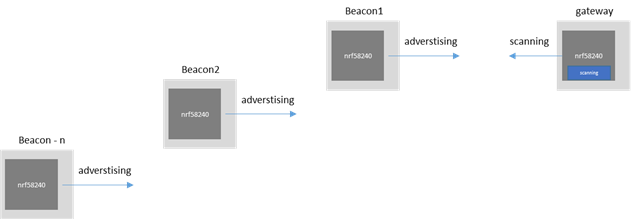Hi,
actually we have following Solution:
- NO battery powered devices
- the first nrf58240 acts as a beacon advertsing temperature values all 10sec
- On our gateway, there is also nrf58240 which is in continuous scanning mode.. and catches the advertsiments.
--> it is working fine

We need to extended this structure. The beacons are located in building
We need to extended this structure. The beacons are located in building
- add many (up to 200 beacons) in a line-- the one is near to the gateway, the next is more far away, the 3rd is much more away and so on
- the main problem what we see is the distance, the router is not able to catch the advertisments of the far away located beacons inside the building
--> clear this is what we expected ;-)

Solution?
- we checked the mesh functuioniality, but: we dont need the steps of Provisioning with Discovery, Authentication, Addressing assignment and network information exchange
and the steps of Configuration --> every node is allowed to send its data to the gateway, let me say-- the data are open and the information is not secret. So we dont need this Meshstack functuionality on top of the BLE. nevertheless we need a mechnaismus to relay the data from one node to the other ---to bridge the distance.
So we thought about following architecture:
- Each beacon should not only advertise, it should also scan e.g. 10seconds adverstising every 1s, 2 seconds scanning and catch the advertisments from other beacons
So for example:
Beacon 1 send advertisments from itself
Beacon 1 scanns and catches advertisments from beacon 2 and 3 - these shoukld be forwarded as adverstiments togehther with its own advertisments

Questions
1) In the moment we would scan in these 2 seconds?.. is there a function availbale for example to scan and forward these "input" as advertiosments? ..such as the relay node in the meshnetwork..? it should be without any authentification or something - just scanning and forwarding
2) if we deploy e.g. 200 nodes.. at the end the beacon1 received e.g. 200 temperature values. Do you see any issue here for beacon1?
3) Pls also recommend something if you would say..there could be a easier solution?

